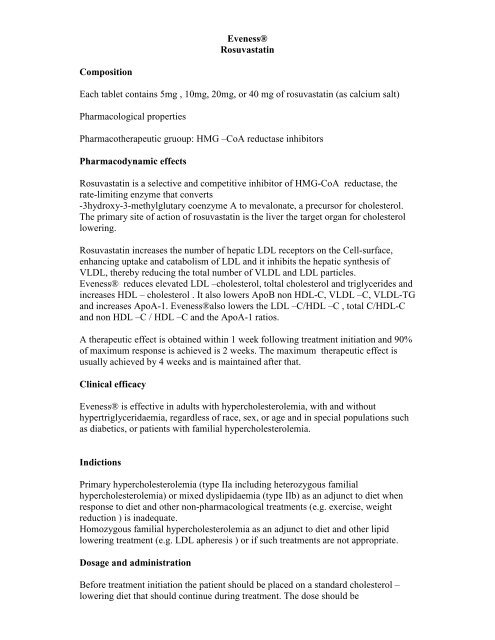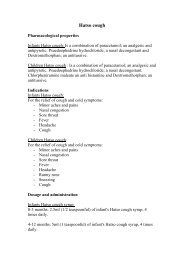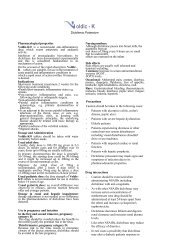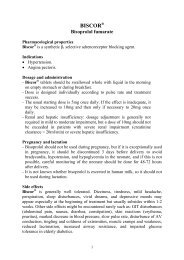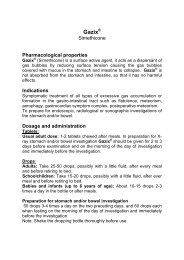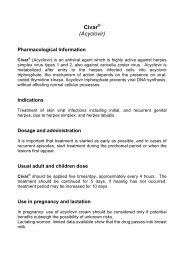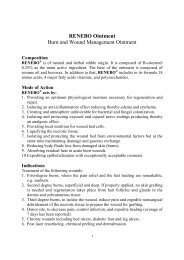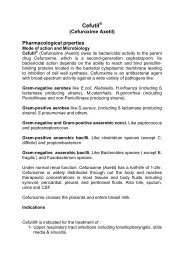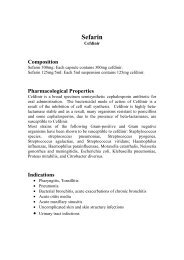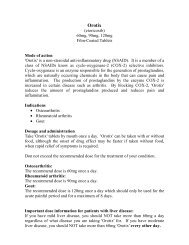Download Leaflet - PIC-JO > Home
Download Leaflet - PIC-JO > Home
Download Leaflet - PIC-JO > Home
- No tags were found...
You also want an ePaper? Increase the reach of your titles
YUMPU automatically turns print PDFs into web optimized ePapers that Google loves.
Eveness®RosuvastatinCompositionEach tablet contains 5mg , 10mg, 20mg, or 40 mg of rosuvastatin (as calcium salt)Pharmacological propertiesPharmacotherapeutic gruoup: HMG –CoA reductase inhibitorsPharmacodynamic effectsRosuvastatin is a selective and competitive inhibitor of HMG-CoA reductase, therate-limiting enzyme that converts-3hydroxy-3-methylglutary coenzyme A to mevalonate, a precursor for cholesterol.The primary site of action of rosuvastatin is the liver the target organ for cholesterollowering.Rosuvastatin increases the number of hepatic LDL receptors on the Cell-surface,enhancing uptake and catabolism of LDL and it inhibits the hepatic synthesis ofVLDL, thereby reducing the total number of VLDL and LDL particles.Eveness® reduces elevated LDL –cholesterol, toltal cholesterol and triglycerides andincreases HDL – cholesterol . It also lowers ApoB non HDL-C, VLDL –C, VLDL-TGand increases ApoA-1. Eveness®also lowers the LDL –C/HDL –C , total C/HDL-Cand non HDL –C / HDL –C and the ApoA-1 ratios.A therapeutic effect is obtained within 1 week following treatment initiation and 90%of maximum response is achieved is 2 weeks. The maximum therapeutic effect isusually achieved by 4 weeks and is maintained after that.Clinical efficacyEveness® is effective in adults with hypercholesterolemia, with and withouthypertriglyceridaemia, regardless of race, sex, or age and in special populations suchas diabetics, or patients with familial hypercholesterolemia.IndictionsPrimary hypercholesterolemia (type IIa including heterozygous familialhypercholesterolemia) or mixed dyslipidaemia (type IIb) as an adjunct to diet whenresponse to diet and other non-pharmacological treatments (e.g. exercise, weightreduction ) is inadequate.Homozygous familial hypercholesterolemia as an adjunct to diet and other lipidlowering treatment (e.g. LDL apheresis ) or if such treatments are not appropriate.Dosage and administrationBefore treatment initiation the patient should be placed on a standard cholesterol –lowering diet that should continue during treatment. The dose should be
individualized according to the goal of therapy and patient response, using currentconsensus guidelines.The recommended starting dose is 5mg or 10 mg orally once daily in both statin naïveor patients switched from another HMG-CoA reductase inhibitor. The choice of astarting dose should take into account the individual patent’s cholesterol level andfuture cardiovascular risk as well as the potential risk for adverse reactions. A doseadjustment to the next dose level can be mad after 4 weeks, if necessary. In light ofthe increased reporting rate of adverse reactions with the 40 mg dose compared tolower doses, a final titration to severe hypercholesterolemia , who do not achieve theirtreatment goal on 20 mg, and in whom routine follow – up will be performed.Specialist supervision is recommended when the 40 mg dose is initiated.Eveness® may be given at any time of day, with or without food.Pediatric useSafety and efficacy have not been established in children. Paediatric experience islimited to a small number of children (aged 8 years or above) with homozygousfamilial hypercholesterolaemia. Therefore, Eveness® is not recommended forpaediatric use at this time.Use in the elderlyA starting dose of 5mg is recommended in patients >70 years .No other dose adjustment is necessary in relation to age.Dosage in patients with renal insufficiencyNo dose adjustment is necessary in patients with mild to moderate renal impairment.The recommended starting dose is 5mg in patients with moderate renal impairment(creatinine clearance < 60 ml/ min). The 40 mg dose is contraindicated in patientswith moderate renal impairment. The use of Eveness® in patients with server renalimpairment is contraindicated for all doses (see Contraindications andPharmacokinetic properties).Dosage in patients with hepatic impairmentThere was no increase in systemic exposure to rosuvatatin in subjects with Child –Pugh Scores of 7 or below. However, increased systemic exposure has been observedin subjects with Child –Pugh scores of 8 and 9In these patients an assessment of renal function should be considered. There is noexperience in patients with active liver disease.RaceIncreased systemic exposure has been seen in Asian subjects. The recommendedstarting dose is 5 mg for patients of Asian ancestry. The 40 mg dose is contraindicatedin these patients .Dosage in patients with pre-disposing factors to myopathyThe recommended starting dose is 5 mg in patients with predisposing factors tomyopathy. The 40 mg dose is contraindicated in some of these patients .ContraindicationsEveness® is contraindicated:-in patients with hypersensitivity to rosuvastatin or to any of the excipients.
-In patients with active liver disease including unexplained, persistent elevations ofserum transminases and any serum transaminase elevation exceeding 3 x the upperlimit of normal (ULN)-In patients with severe renal impairment (creatinine clearance < 30 ml/min).-In patients with myopathy.-In patients receiving concomitant ciclosporin-During pregnancy and lactation and in women of childbearing potential not usingappropriate contraceptive measures.The 40 mg dose is contraindicated in patients with pre-disposing factors for myopathy/ rhabdomyolysis. Such factors include:-moderate renal impairment (creatinine clearance 60 ml/min).-hypothyroidism-personal or family history of hereditary muscular disorders-previous history or muscular toxicity with another HMG-CoA reductase inhibitor orfibrate-alcohol abuse-situations where an increase in plasma levels may occur-Asian patients-Comcomitant use of fibrates.Adverse effectsThe adverse events seen with Eveness® are generally mild and transient. Incontrolled clinical trials, less than 4% of Eveness®–treated patients were withdrawndue to adverse events.The frequencies of adverse events are ranked according to the following: Common(>1/10, 1/100,
Skeletal muscle effects: Effects on skeletal muscle e.g. myalgia, myopathey)including myositis ) and , rarely, rhabdomyolyiss have been reported in rosuvastatintreatedpatients with all doses and in particular with doses >20 mg.A dose –related increase in CK levels has been observed in patients takingrosuvastatin; the majority of cases were mild, asymptomatic and transient. If CKlevels are elevated (>5x ULN), treatment should be discontinued (see Specialwarnings and precautions for use).Liver effects :As with other HMG –CoA reductase inhibitors, a dose-related increase intransaminases has been observed in a small number of patients taking rosuvastatin;the majority of cases were mild, asymplomatic and transient .Post marketing experience :In addition to the above, the following adverse events have been reported during postmarketingexperience for rosuvastatin:Hepatobiliary disorders: very rare: jaundice, hepatitis; rare: increased hepatictransminases.Musculoskeletal disorders: Rare: arthralgia.Nervous system disorders: Very rare: polyneuropathy, memory loss.Renal disorders:Very rare :haematuriaThe reporting rates for rhabdomyolysis, serious renal events and serious hepaticevents (consisting mainly of increased hepatic transaminases ) is higher at the 40 mgdose.Effects on ability to drive and use machinesStudies to determine the effect of rosuvastatin on the ability to drive and use machineshave not been conducted. However, based on its pharmacodynamic properties,rosuvastatin is unlikely to affect this ability. When driving vehicles or operatingmachines, it should be taken into account that dizziness may occur during treatment.Warnings and PrecutionsRenal effectsProteinuria, detected by dipstick testing and mostly tubular in origin, has beenobserved in patients treated with higher doses of Eveness®, in particular 40 mg,where it was transient or intermittent in most cases. Proteinuria has not been shown tobe predictive of acute or progressive renal events in post-marketing use are higher atthe 40 mg dose. An assessment of renal function should be considered during routinefollow-up of patients treated with a dose of 40 mg.Skeletal muscle effectsEffects on skeletal muscle e.g. myalgia, myopathy and , rarely, rhabdomyolysis havebeen reported in Eveness® -treated patients with all doses and in particular with doses>20 mg. Very rare cases of rhabdomyolsis have been reported with the use ofezetimibe in combination with HMG-CoA reductase inhibitors, and caution should beexercised with their combined use .As with other HMG-CoA reductase inhibitors, the reporting rate for rhabdomyloysisassociated with rosuvastatin in post- marketing use is higher at the 40 mg dose.Creatine Kinase measurement
Creatine Kinase (CK) should not be measured following strenuous exercise or in thepresence of plausible alternative cause of CK Increase which may confoundinterpretation of the result. if CK levels are significantly elevated at baseline(>5xULN) an confirmatory test should be carried out within 5-7 days, if the repeattest confirms a baseline CK >5xULN, treatment should not be started .Before treatmentEveness®. As with other HMG-CoA reductase inhibitors, should be prescribed withcaution in patients with pre–disposing factors for myopathy/rhabdomyolysis . Suchfactors include:-Renal impairment-Hypothyroidism-Personal or family history of hereditary muscular disorders-Previous history of muscular toxicity with another HMg- CoA reductase inibitor orfibrate-Alcohol abuse-Age >70 years-Situations where an increase in plasma levels may occur ( see Pharmacokineticproperties )-Concomitant use of fibratesIn such patients the risk of treatment should be considered in relation to possiblebenefit and clinical monitoring is recommended. If CK levels are significantlyelevated at baseline (>5x ULN) treatment should not be startedWhilst on treatment.Patients should be asked to report inexplicable muscle pain, weakness or crampsimmediately, particularly if associated with malaise or fever .Ck levels should be measured in these patients. Thearapy should be discontinued ifCK levels are markedly elevated (>5xULN) or if muscular symptoms are severe andcause daily discomfort (even if CK levels are ≤5xULN). If symptoms resolve and Cklevels return to normal, then consideration should be given to re-introducingEveness® or an alternative HMG-CoA reductase inhibitor at the lowest dose withclose monitoring.Routine monitoring of CK levels in asmptomatic patients is not warranted.In clinical trials there was no evidence of increased skeletal muscle effects in thesmall number of patients dosed with rosuvastatin and concomitant therapy. However,an increase in the incidence of myositis and myopathy has been seen in patientsreceiving other HMG-CoA reductase inhibitors together with fibric acid derivativesincluding gemfibrozil, ciclosporin, nicotinic acid, azole antifungals, proteaseinhibitors and macrolide antibiotics, Gemfibrozil increases the risk of myopathy whengiven concomitantly with some HMG-CoA reductase inhibitors. Therefore, thecombination of Eveness® and gemfibrozil is not recommended. The benefit of furtheralterations in lipid levels by the combined use of Eveness® with fibrates or niacinshould be carefully weighed against the potential risks of such combinations. The 40mg dose is contraindicated with concomitant use of a firbrate.Eveness® should not be used in any patient with an acute, serious conditionsuggestive of myopathy or predisposing to the development or renal failure secondaryto rhabdomyolysis (e.g. sepsis, hypotension, major sugery, trauma, severe metabolic,endocrine and electrolyte disorders; or uncontrolled seizures).Liver effectsAs with other HMG-COA reductase inhibitors, Eveness® should be used with cautionin patients who consume excessive quantities of alcohol and /or have a history of liverdisease .
It is recommended that liver function tests be carried out prior to, and 3 monthsfollowing, the initiation of treatment. Eveness® should be discontinued or the dosereduced if the level of serum transminses is greater than 3 times the upper limit ofnormal. The reporting rate for serious hepatic events (consisting mainly of increasedhepatic transaminases) in post- marketing use is higher at the 40 mg dose. In patientswith secondary hypercholesterolaemia caused by hypothyroidism or nephriticsyndrome, the underlying diseases should be treated prior to initiating therapy withrosuvastatin .RacePharmacokinetic studies show an increase in exposure in Asian subjects comparedwith Caucasians .Protease inhibitorsThe concomitant use with protease inhibitors is not recommended .Drug interactionsCiclosporin: During concomitant treatment with Eveness® and cicloporin,rosuvastatin AUC values were on average 7 times higher than those observed inhealthy volunteers. Concomitant administration did not affect plasma concentration ofciclosporinVitamin K antagonists: As with other HMG-CoA reductase inhibitors, the initiation oftreatment or dosage up- titration of Eveness® in patients treated concomitantly withvitamin K antagonists (e.g. warfarin or another coumarin anticoagulants) may resultin an increase in international Normalized Ratio ( INR) . Discontinuation or downtitrationof Eveness® may result in a decrease in INR. Such is Desirable.Ezetimibe: concomitant use of Eveness® and ezetimibe resulted in no change to AUCor Cmax for either drug. However, a pharmacodynamic interaction, in terms ofadverse effects, between Eveness® and ezetimibe cannot be ruled out .Gemfibrozil and other lipid-loweing products: Concomitant use of Eveness® andgemfibrozil resulted in a 2- fold increase in rosuvastatin Cmax and AUC .Based on data from specific interaction studies no pharmacokinetic relevantinteraction with fenofibrate is expected, however a pharmacodynamic interaction mayoccur. Gemfibrozil fenofibrate, other fibrated and lipid loweing doses (>or equal to 1g/ day ) of niacin (nicotinic acid increase the risk of myopathy when givenconcomitantly with HMG-CoA reductast inhibitors, probably because they canproduce myopathy when given alone. The 40 mg dose is contraindicated withconcomitant use of a fibrate. These patients should also start with the 5 mg dose.Protease inhibitors: Although the exact mechanism of interaction is unknown,concomitant protease inhibitor use may strongly increase rosuvastatin exposure, in apharmacokikinetic study, co- administration of 20 mg rosuvastatin and combinationproduct of two protease inhibitors (400 mg lopinavir / 100mg ritonavir) in healthyvolunteers was associated with an approximately two –fold increase in rosuvastatinsteady-state AUC (0-24) and C max respectively. Therefore, concomitant use ofrosuvastatin in HIV patients receiving protease inhbitors is not recommended .Antacid: The simultaneous dosing of Eveness® with an antacid suspension containingaluminum and magnesium hydroxide resulted in a decrease in rosuvastatin plasmaconcentration of approximately 50%. This effect was mitigated when the antacid wasdosed 2 hours after Eveness®. The clinical relevance of this interaction has not beenstudied .
Oral contraceptives / hormone replacement therapy ( HRT):Concomitant use of Eveness® and an oral contraceptive resulted in an increase inethinyl estradiol and norgestrel AUC of 26% and 34%respectively these increasedplasma levels should be considered when selecting oral contraceptive doses. There areno pharmacokinetic data available in subjects taking concomitant rosuvastatin andHRT and therefore a similar effect cannot be excluded. However the combination hasbeen extensibely used in women in clinical trials and was well tolerated .Other medicinal products: Based on data from specific interaction studies noclinically relevant interactions with digoxin are expected.Cytochrome P450 enzymes: results from in vitro and in vivo studies show thatrosuvastatin is neither an inhibitor nor an inducer of cytochrome P450 isoenzymes. Inaddition, resuvastain is poor substrate for these isoenzyems. No clinicaly relevantinteractions have been observed between rosuvastatin and either fluconazole ( aninhibitor of CYP3A4) concomitant administration of itraconazole ( an inhibitor ofCYP3A4) and rosuvastatin resulted in a 28 % increase In AUC of rosuvastatin. Thissmall increase is not considered clinically significant. Therefore, drug interactionsresulting from cytochrome P450- mediated metabolism are not expected .OverdoseThere is no specific treatment in the event of overdose. In the event of overdose, thepatient should be treated symptomatically and supportive measures instituted asrequired. Liver function and CK levels should be monitored. Haemodialysis isunlikely to be of benefit.Use in pregnancy & lactationEveness® is contraindicated in pregnancy and lactation.Women of child –bearing potential should use appropriate contraceptive measures.Since cholesterol and other products of cholesterol biosynthesis are essential for thedevelopment of the foetus, the potential risk from inhibition of HMG-COA reductaseoutweighs the advantage of treatment during pregnancy. Animal studies providelimited evidence of reproductive toxicity. If patient becomes pregnant during use ofthis product, treatment should be discontinue immediately.Rosuvastatin is excreted in the milk of rats. There are no data with respect toexcretion in milk in humans .PresentationEveness® 5 mg F/C tablet: Rosuvastatin 5 mg/tab (30 tablets).Eveness®10 mg F/C tablet: Rosuvastatin 10 mg/tab (30 tablets).Eveness® 20 mg F/C tablet: Rosuvastatin 20 mg/tab (28 tablets).Eveness® 40 mg F/C tablet: Rosuvastatin 40mg/tab (28 tablets).


